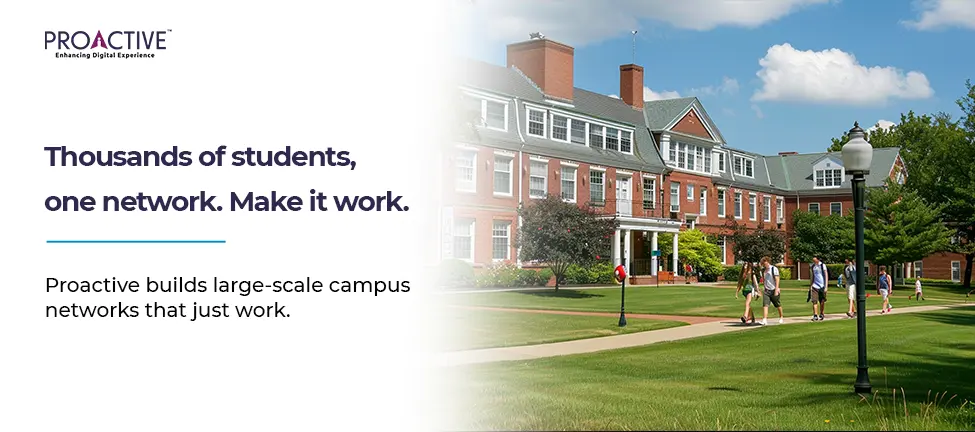Updated: July 11, 2025

The real backbone of a campus isn’t the library; it’s the network.
Universities across India, from Delhi and Pune to Guwahati, are expanding fast. Classrooms have gone hybrid. Hostels stream lectures late into the night. Administrative systems, biometric attendance, and online exam portals run on a digital backbone that few outside the IT team ever think about.
Until it fails.
One glitch during the final exams. One unsecured device in a crowded hostel. One overlooked access point during admissions. That’s all it takes to expose student data, disrupt schedules, or bring a campus to a halt. If your university runs on connectivity, it’s time to treat the network as mission-critical.
What Makes University Networks So Demanding?
Campuses are unique. They combine the density of a tech park with the unpredictability of a public venue. Thousands of users. Dozens of building types. Constant churn of devices and roles. And an environment that expects Wi-Fi like water.
Here’s what makes university networks harder to manage:
Six Proven Tips for Better Campus Networking
1. Design by Density, Not by Distance
Many campuses place access points based on room size instead of how many people and devices actually use the space. A seminar hall with 200 students using laptops is not the same as a storage room.
What to do: Use heat mapping and device density data to place Wi-Fi 6 access points where they’re actually needed. Design for peak loads, not empty rooms.
2. Segment Like an Urban Planner
Everyone shares the same airwaves, but they shouldn’t share the same network. Faculty, students, admin staff, guest users, and IoT devices should all live on separate VLANs with custom access rules.
What to do: Build VLANs based on roles. Apply bandwidth controls, isolation policies, and logging on a per-role basis. This protects sensitive data and prioritises critical applications.
3. Move to Cloud-Managed Infrastructure
When buildings span acres and users roam between zones, on-prem controllers are a bottleneck.
What to do: Use platforms like Cisco Meraki or Catalyst Center to manage Wi-Fi, switching, and security from a single dashboard. Push updates, track device health, and run diagnostics remotely.
4. Plan for the Academic Calendar
Exams. Admissions. Events. These aren’t just academic milestones, they’re bandwidth spikes.
What to do: Use analytics to anticipate usage surges. Prioritise traffic during peak periods. Schedule upgrades and maintenance during semester breaks.
5. Secure Without Slowing Down
You can’t block students from bringing their own devices. But you can control what connects, how, and when.
What to do: Use identity-based access control. Apply posture checks. Enforce authentication for every device and user. Tools like Cisco ISE and Duo make this easier without adding complexity.
6. Monitor Everything, Act Early
Networks fail silently, without warning. One misbehaving switch, one AP with a bad cable, one student device flooding the network. Without visibility, your IT team will always play catch-up.
What to do: Use smart alerts, AI-based anomaly detection, and integrated dashboards. Set thresholds for latency, packet loss, and user load. Act before users even notice.
Why This Matters Now
India is home to over 1,100 universities and nearly 45,000 colleges. As digital classrooms, e-learning platforms, and AI-based tools become mainstream, the load on networks will multiply.
According to a 2023 report by IndiaEdTech Consortium, 78% of universities plan to digitise 60% or more of their operations by 2026. That includes everything from smart classrooms to digital ID cards. Without a robust network, none of that vision holds.
What Proactive Does for Universities
Proactive works with leading educational institutions to build and manage campus networks that scale. We design for capacity, not guesswork. Our teams deploy cloud-managed Wi-Fi, segment access by role, and provide 24x7 monitoring for always-on performance.
Whether your university runs a single campus or multiple sites, we help you unify control, improve uptime, and reduce IT overhead. In institutions across Bengaluru, Lucknow, and Visakhapatnam, our Cisco-powered solutions run digital classrooms, admin portals, and hostel networks with zero disruption.
Ask These Questions
If you hesitated, it’s time to redesign.